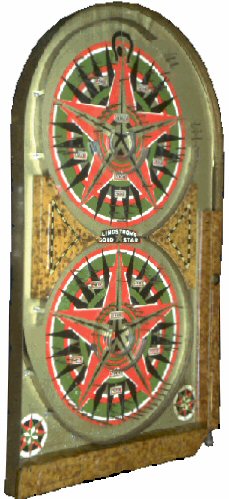
This well known tabletop Bagatelle game was purchased by the Museum in 1982 at a Flea Market in Ontario, Canada. It originally appeared on the commercial market about 1934, manufactured by the Lindstrom Tool and Toy Company, Bridgeport, Conn., in the United States. It is pictured in: B.C. Natikin & S. Kirk, All About Pinball, New York: Gosset & Dunlap, 1977, p. 20.
The board is 61cm long x 36cm wide x 3cm high. It's made of wood, printed paper, tin, and uses nails and metal strips as marble deflectors in various places on the board's surface. A number of target holes are cut into various parts of the board. Instructions for playing and scoring the game are printed on the reverse side of the board. The intent of the game is to accumulate points by having a marble land in a target hole on the board's surface.
For proper play, the top of the board should be raised upon a support on the table so that the bottom of the board sits on the table and the entire board slants downward toward the player. Like most standard tabletop Bagatelle games, this game was designed for a right-handed player. On the right side of the board is a Runway - a covered metal channel with an open hole half way up its length in which to place a marble. The function of the Runway is to direct the marble to the top surface of the board. When a marble is placed in the Runway hole and the board is properly slanted, the marble rolls down the Runway and rests against a Plunger - a spring-loaded cylindrical rod which when operated by the player, propels the marble up the Runway.
When a player pulls the Plunger and releases it, the Plunger cylinder hits the marble, propels it up the Runway, and then gravity takes over and the marble rolls down the slated board surface. The degree of propulsive force upon the marble is dependent upon how far out a player extents the Plunger from the board and how quickly the Plunger is released. Different degrees of force cause the marble (during its decent on the board surface) to rebound against the sides of the board and against the embedded nails which act as deflectors. There are also a number of Guide Rails - metal strips attached to the board surface which cause the marble to be directed to a specific area on the surface. As the marble rebounds against the nails, or is directed by a Guide Rail as it rolls down the board's surface, it either falls into a target hole (resulting in a player accumulating scoring points), or comes to rest at the bottom of the board without resulting in a player accumulating any score for that "shot". Depending upon the decisions of the players involved, a game can continue by retrieving the marble and the same player can start the process anew or another player can have a turn. For example: the method of play decided upon may entitle each player to have 3 "shots" in a row in order to accumulate scoring points.
Last update February 25, 2010